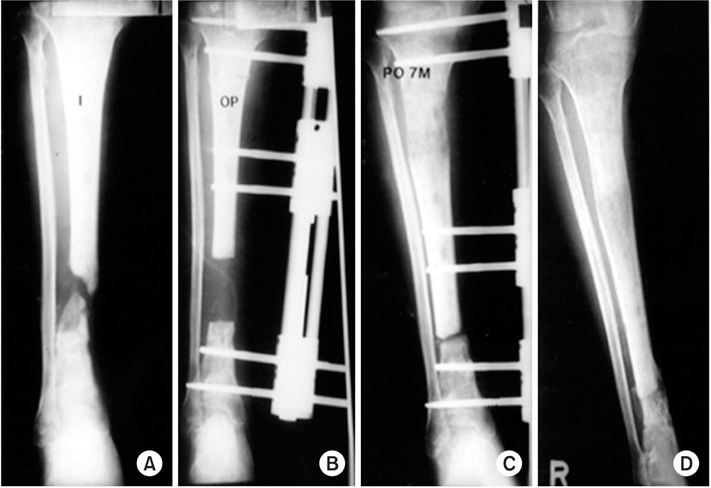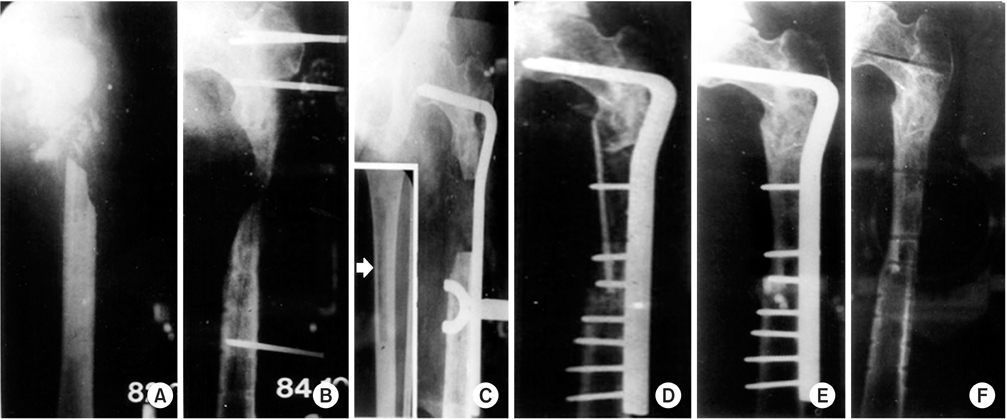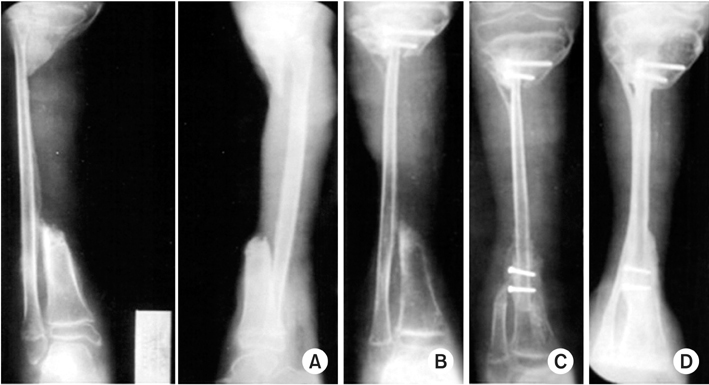J Korean Fract Soc.
2017 Jan;30(1):1-8. 10.12671/jkfs.2017.30.1.1.
Treatment of Wide Gap Non-Unions in Lower Extremities
- Affiliations
-
- 1Department of Orthopaedic Surgery, Daejeon Sun Hospital, Daejeon, Korea. Skrhee@catholic.ac.kr
- KMID: 2367346
- DOI: http://doi.org/10.12671/jkfs.2017.30.1.1
Abstract
- PURPOSE
To analyze the end results of the treatment for patients with wide gap non-unions of the long bones in the lower extremities.
MATERIALS AND METHODS
A total of 62 cases of wide gap unions, with a mean age of 38 years, were included for analysis. Study cohort included six children under the age of seven years. The average size of established bone defect was 7 cm (4-23 cm). Bone defects under 7 cm were treated with plating and various bone grafts, and those over 7 cm were managed with vascularized fibular graft (VFG), distraction-osteogenesis, tibial strut, plating and etc. Two boys with a defect of the whole tibia but with an intact fibula were treated with tibialization of intact fibula and with rotation-plasty of the leg. Their end results were evaluated by the time of bony union in accordance with the treatment of defect size of the long bone as well as their age.
RESULTS
Bony unions were obtained for an average period of at least 27 months. Fifty-one cases showed an average leg-length discrepancy of 2.8 cm, and 11 cases showed no leg-length discrepancy. The VFG, distraction-osteogenesis, and tibial cortical-strut graft and plating were the most effective methods for non-unions of wide, long bone defections (>7 cm). The prognosis was more favorable in children, muscular femur, and in cases with tibial defect but intact fà bula.
CONCLUSION
Various bone union techniques should be considered carefully, considering the ages of patients and the size of bone defects. Due to severe physical and mental disabilities of patients during the long-treatment period, specialized orthopedic doctors for trauma and mental care were necessary.
Keyword
MeSH Terms
Figure
Reference
-
1. Crist BD, Ferguson T, Murtha YM, Lee MA. Surgical timing of treating injured extremities: an evolving concept of urgency. Instr Course Lect. 2013; 62:17–28.2. Finkemeier CG, Schmidt AH, Kyle RF, Templeman DC, Varecka TF. A prospective, randomized study of intramedullary nails inserted with and without reaming for the treatment of open and closed fractures of the tibial shaft. J Orthop Trauma. 2000; 14:187–193.
Article3. Wang HT, Erdmann D, Fletcher JW, Levin LS. Anterolateral thigh flap technique in hand and upper extremity reconstruction. Tech Hand Up Extrem Surg. 2004; 8:257–261.
Article4. Duan X, Al-Qwbani M, Zeng Y, Zhang W, Xiang Z. Intramedullary nailing for tibial shaft fractures in adults. Cochrane Database Syst Rev. 2012; 1:CD008241.
Article5. Young S, Lie SA, Hallan G, Zirkle LG, Engesæter LB, Havelin LI. Risk factors for infection after 46,113 intramedullary nail operations in low- and middle-income countries. World J Surg. 2013; 37:349–355.
Article6. Papineau LJ. Excision-graft with deliberately delayed closing in chronic osteomyelitis. Nouv Presse Med. 1973; 2:2753–2755.7. Papineau LJ, Alfageme A, Dalcourt JP, Pilon L. Chronic osteomyelitis: open excision and grafting after saucerization (author's transl). Int Orthop. 1979; 3:165–176.8. Huntington TW. VI. Case of bone transference: use of a segment of fibula to supply a defect in the tibia. Ann Surg. 1905; 41:249–251.9. Van-Ness CP. Rotation-plasty for congenital defects of the femur. Making use of the ankle of the shortened limb to control the knee joint of the prosthesis. J Bone Joint Surg Br. 1950; 31:12–16.10. Ilizarov GA, Deviatov AA, Trokhova VG. Surgical lengthening of the shortened lower extremities. Vestn Khir Im I I Grek. 1972; 108:100–103.11. Ring D, Jupiter JB, Gan BS, Israeli R, Yaremchuk MJ. Infected nonunion of the tibia. Clin Orthop Relat Res. 1999; (369):302–311.
Article12. Shahid M, Hussain A, Bridgeman P, Bose D. Clinical outcomes of the Ilizarov method after an infected tibial non union. Arch Trauma Res. 2013; 2:71–75.
Article13. Taylor GI, Miller GD, Ham FJ. The free vascularized bone graft. A clinical extension of microvascular techniques. Plast Reconstr Surg. 1975; 55:533–544.14. El-Gammal TA, El-Sayed A, Kotb MM. Hypertrophy after free vascularized fibular transfer to the lower limb. Microsurgery. 2002; 22:367–370.15. Ikeda K, Tomita K, Hashimoto F, Morikawa S. Long-term follow-up of vascularized bone grafts for the reconstruction of tibial nonunion: evaluation with computed tomographic scanning. J Trauma. 1992; 32:693–697.
Article16. Hsu RW, Wood MB, Sim FH, Chao EY. Free vascularised fibular grafting for reconstruction after tumour resection. J Bone Joint Surg Br. 1997; 79:36–42.17. Lazar E, Rosenthal DI, Jupiter J. Free vascularized fibular grafts: radiographic evidence of remodeling and hypertrophy. AJR Am J Roentgenol. 1993; 161:613–615.
Article18. Wada T, Usui M, Nagoya S, Isu K, Yamawaki S, Ishii S. Resection arthrodesis of the knee with a vascularised fibular graft. Medium- to long-term results. J Bone Joint Surg Br. 2000; 82:489–493.19. de Boer HH, Wood MB. Bone changes in the vascularised fibular graft. J Bone Joint Surg Br. 1989; 71:374–378.20. Bos KE, Besselaar PP, vd Eijken LW, Raaymakers EL. Failure of hypertrophy in revascularised fibula grafts due to stress protection. Microsurgery. 1996; 17:366–370.
Article21. Chew WY, Low CK, Tan SK. Long-term results of free vascularized fibular graft. A clinical and radiographic evaluation. Clin Orthop Relat Res. 1995; (311):258–261.22. Hahn E. Eine methode, pseudarthrosen der tibia mit grossen knockendefekt zur heilung zu bringen. Zentralbl f Chir. 1884; 11:337–341.23. Kim SS, Cha HS. Rotation-plasty for the treatment of the malignant bone tumor - 2 cases reports. J Korean Orthop Assoc. 1983; 18:794–798.
Article24. Kim JM, Rhee SK, Kim Y, Shin JH. A rotaion-plasty for focal femoral deficiency due to chronic osteomyelitis. J Korean Orthop Assoc. 1989; 24:84–88.







